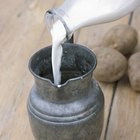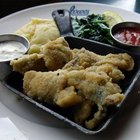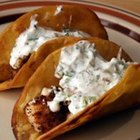
Whether you dress it up with lobster or make a quick, stove-top version tossing in a few handfuls of frozen peas, mac and cheese is a popular American comfort food among adults and children. Using milk instead of cream allows you to avoid unnecessary calories and saturated fats, and it won't taste overly rich and heavy.
Milk
Not only can you substitute whole milk for the cream in mac and cheese, but you can also substitute low-fat, fat-free or evaporated milk in the same proportions as cream. Some recipes retain the dish's creaminess by using a few tablespoons of Greek yogurt or even cubes of cooked butternut squash to add a gooey texture. Other recipes use milk for 100 percent of the liquid, and some combine milk with chicken stock.
Mac and Cheese Basics
Baked mac and cheese begins with a roux of flour, butter and milk that you then turn into a white sauce with more milk and plenty of shredded cheese. Add the sauce and cooked macaroni to an oven-proof pan, stir it thoroughly and layer buttered breadcrumbs on top to balance the pasta's creaminess. Bake the mixture in a 350-degree Fahrenheit oven for about 30 minutes until the breadcrumbs turn golden brown.
Cooking Milk
When using milk instead of cream, it's important to heat the white sauce slowly over medium heat so the milk won't curdle before it thickens. You can boil cream with no consequences, but milk curdles at high temperatures over 180 degrees Fahrenheit. If curdling occurs, the dish becomes grainy and looks unappetizing, with lumpy bits strewn throughout.
Mac and Cheese Tips
The best mac and cheese has noodles that are not overcooked. Remove the noodles from their cooking pot while they are still a bit undercooked, or al dente, because they will continue to cook and absorb liquid once they are in the oven. If you want to add additional ingredients, such as broccoli florets, peas or flaked salmon, pre-cook those items so they will be tender and won't make the mac and cheese runny.
Related Articles

How to Cook Elbow Macaroni in Milk

How to Use Ricotta Cheese for Cream ...

How to Make Cheesy Potatoes Without ...

How to Keep Scalloped Potatoes From ...
Homemade Cream of Chicken Soup Recipe

How to Use Panko

How to Cook Luglug Cornstarch Noodles
How to Freeze Ahead Chicken Casserole

Whole Milk Vs. Lactaid Milk
Homemade Cream of Mushroom Soup Recipe

How to Keep Milk From Separating in ...

How to Make Fish Taco Sauce

How to Make French Sauce With Roux of ...

How to Make Frosting Using All-Purpose ...

How to Make Penne Vodka With No Heavy ...

How Long Can You Refrigerate Nacho ...

List of Latin American Foods

Why Does Milk Curdle When it Is Mixed ...

Can White Gravy Be Made With Almond ...

How to Cook With Havarti Cheese
References
Writer Bio
Susan Lundman began writing about her love of cooking, ingredient choices, menu planning and healthy eating after working for 20 years on children's issues at a nonprofit organization. She has written about food online professionally for ten years on numerous websites, and has provided family and friends with homemade recipes and stories about culinary adventures. Lundman received her M.A. from Stanford University.
Photo Credits
Spike Mafford/Photodisc/Getty Images